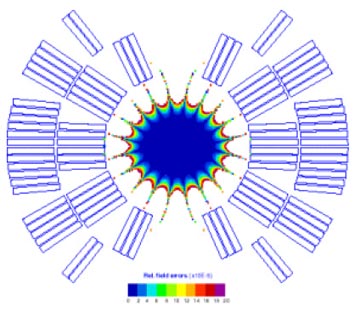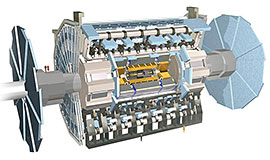Future Upgrades

Magnetic field inside a Nb3Sn quadropole magnet.
Brookhaven leads various technical coordination efforts for the upgrade of the ATLAS detector, including constructing the new silicon tracker, liquid argon electronics, and the new muon chambers.
Brookhaven also contributes to the commissioning and future upgrade of the LHC itself in two areas: accelerator physics and superconducting magnets. This work is carried out as part of the U.S. LHC Accelerator Research Program (LARP) in collaboration with Fermilab, Lawrence Berkeley National Lab, and the Stanford Linear Accelerator Center. The ultimate goal of the upgrade program is to increase the rate of particle collisions, a measure known as luminosity.
Detector Upgrades
Upgrades to luminosity will take place in two phases starting in 2020 and 2025, respectively. The higher energy and luminosity will open a larger window for the discovery of new physics with ATLAS and also enable more precision measurements of the Higgs boson, including how it couples with other elementary particles to impart mass.
To make the most of those capabilities, Brookhaven Lab has actively proposed, designed, and is building key components of the Phase I ATLAS upgrade, including a higher granularity calorimeter trigger to improve selection of certain particles, a front-end readout in the new small wheel muon detector, a global feature extractor for the large area jet trigger in the Trigger and Data Acquisition (TDAQ) system, and a new approach to interface on-detector electronics. For the Phase II upgrade of ATLAS, Brookhaven is proposing an integrated front-end readout to significantly reduce power and simplify the front-end system of the liquid argon calorimeter and major contributions to a new silicon tracker.
Brookhaven and LARP
Much of the work for the U.S. LHC Accelerator Research Program (LARP) uses Brookhaven's Relativistic Heavy Ion Collider (RHIC) as a "test bed" for the beam-based development of devices destined for the LHC, and Brookhaven physicists with expertise in accelerators and magnet designs make important contributions to this work. The LHC tune and chromaticity feedback hardware and algorithms, for example, were developed through collaboration between LARP and CERN in the RHIC collider. “Electron lenses," first operated in the Tevatron at Fermilab and used successfully at RHIC to compensate for beam-beam disruptions in colliding proton beams, are also considered for the LHC, although in a configuration where they are part of the collimation system. Brookhaven physicists have also been leaders in an international collaboration to develop "crab cavities," which allow proton bunches to collide (slightly) sideways as they pass through collision points to increase luminosity while also allowing larger crossing angles to further minimize the damage done by the beam-beam effect.
CERN has just concluded Long Shutdown 1, in which the interconnections between the magnets were upgraded to allow the protons to be accelerated to higher energies. Long Shutdown 2 begins in 2018, focused on upgrades to the injector chain (without Brookhaven involvement), but Long Shutdown 3, beginning in 2023, will incorporate major advances developed in part at Brookhaven to further improve luminosity. These include quadrupoles made with a higher-performing superconductor, Nb3Sn, to replace the existing NbTi superconducting quadrupoles, which are being developed by a collaboration of physicists from Brookhaven Lab, Fermilab, and, Berkeley Lab (see related story), as well as crab cavities.



